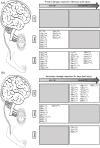A Review of MicroRNA Biomarkers in Traumatic Brain Injury
- PMID: 30886525
- PMCID: PMC6410383
- DOI: 10.1177/1179069519832286
A Review of MicroRNA Biomarkers in Traumatic Brain Injury
Abstract
There is growing public concern surrounding traumatic brain injury (TBI). TBI can cause significant morbidity, and the long-term sequelae are poorly understood. TBI diagnosis and management rely on patient-reported symptoms and subjective clinical assessment. There are no biologic tools to detect mild TBI or to track brain recovery. Emerging evidence suggests that microRNAs (miRNAs) may provide information about the injured brain. These tiny epigenetic molecules are expressed throughout the body. However, they are particularly important in neurons, can cross the blood-brain barrier, and are securely transported from cell to cell, where they regulate gene expression. miRNA levels may identify patients with TBI and predict symptom duration. This review synthesizes miRNA findings from 14 human studies. We distill more than 291 miRNAs to 17 biomarker candidates that overlap across multiple studies and multiple biofluids. The goal of this review is to establish a collective understanding of miRNA biology in TBI and identify clinical priorities for future investigations of this promising biomarker.
Keywords: Concussion; biomarkers; diagnosis; miRNA; prognosis; traumatic brain injury; treatment.
Conflict of interest statement
Declaration of conflicting interests:The author(s) declared the following potential conflicts of interest with respect to the research, authorship, and/or publication of this article: SDH is a paid consultant for Quadrant Biosciences Inc. He is named as an inventor on intellectual property using miRNA technology in patients with traumatic brain injury. AF has no conflicts of interest to disclose.
Figures

References
-
- Raftery M, Kemp S, Patricios J, Makdissi M, Decq P. It is time to give concussion an operational definition: a 3-step process to diagnose (or rule out) concussion within 48 h of injury: World Rugby guideline. Br J Sports Med. 2016;50:642-643. - PubMed
-
- Zonfrillo MR, Master CL, Grady MF, Winston FK, Callahan JM, Arbogast KB. Pediatric providers’ self-reported knowledge, practices, and attitudes about concussion. Pediatrics. 2012;130:1120-1125. - PubMed
-
- Finch CF, McCrory P, Ewing MT, Sullivan SJ. Concussion guidelines need to move from only expert content to also include implementation and dissemination strategies. Br J Sports Med. 2013;47:12-14. - PubMed
Publication types
Grants and funding
LinkOut - more resources
Full Text Sources
Other Literature Sources

